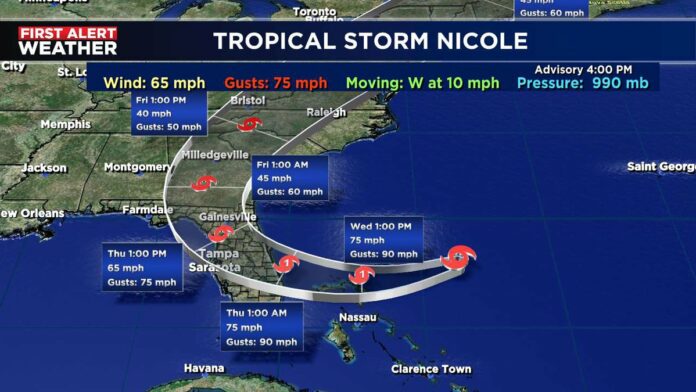
Tropical Storm Nicole was teetering on the brink of hurricane status Wednesday morning, with sustained winds of 70 mph as it churned ever closer to the Florida coastline. Conditions were already beginning to deteriorate in the Sunshine State, where the worst was set to arrive Wednesday evening into early Thursday.
The unseasonable blow to Florida’s Atlantic coastline is just the first act in a multiphase operation that will play out over the coming days. After moving ashore between West Palm Beach and Melbourne, the storm will quickly sweep toward Tampa, likely enter the Gulf of Mexico, make a second landfall along Florida’s Big Bend and then work its way up the East Coast. A strip of very heavy rain will fall all the way north into Canada.
Tropical storm warnings have been hoisted all the way to Charleston and have also been expanded to include the Florida Gulf Coast from near Fort Myers to Tallahassee. Within that area, a hurricane warning spans from near Boca Raton to Daytona Beach, including Palm Beach, Port St. Lucie and the Space Coast.
Storm surge warnings for a “life-threatening” rise in ocean water above normally dry land, stretch from North Palm Beach northward to southeast Georgia midway between Jacksonville and Savannah. Some places could be inundated by up to 5 feet of water if the peak surge coincides with high tide. Additionally, a storm surge warning encompasses coastal regions from north of Tampa Bay through the Big Bend on the Florida’s west coast where up to 4 or 5 feet of shoreline inundation is also possible.
“The storm surge will be accompanied by large and damaging waves,” the National Hurricane Center cautioned. “Residents in the warning area should listen to advice given by local officials.”
Water levels began rising along Florida’s east coast Tuesday and, by Wednesday morning, social media video showed the ocean already overwhelming beaches, leading to coastal erosion and minor to moderate flooding.
Tropical storm conditions were expected to affect eastern Florida beginning around mid- to late morning Wednesday.
Mandatory evacuation orders were issued Tuesday for vulnerable zones of Palm Beach and Volusia counties in Florida in anticipation of the surge. St. Lucie, Brevard, St. Johns, Indian River and Martin counties advocated voluntary evacuation for some residences. Zones of greatest concern include barrier islands, mobile homes and homes in areas prone to flooding.
The National Weather Service wrote the surge could have “significant impacts,” especially from Palm Beach northward with damage to buildings, marinas, docks and piers, as well as washed out roads and major beach erosion.
While the ocean surge may prove to be Nicole’s principle hazard, especially for coastal areas, inland flooding from heavy rain and power outages from strong winds are also possible.
Ahead of the storm, Orlando International Airport announced it would cease commercial operations at 4 p.m. Wednesday and some of Florida’s biggest school systems — including in Miami-Dade and Orlando — announced they were canceling classes on Wednesday.
November is an unusual month for a Florida hurricane. In fact, only five other hurricanes on record have made landfall in the U.S. during November. The year 1985 featured two such storms – Juan and Kate. Before that, you’d have to go back to the unnamed Category 2 hurricane that hit Miami on Nov. 4, 1935.
Despite Nicole’s unusual tardiness, the 2022 season is still running slightly behind average, defying expert predictions of an active season. From a standpoint of ACE, or Accumulated Cyclone Energy, the season to date is lagging 22 percent behind historic averages; ACE is a product of storm intensity and duration, and quantities how much energy from warm ocean waters storms churn through.
As of 10 a.m. Eastern time, Nicole had winds of 70 mph. It was located 25 miles east-northeast of Great Abaco Island in the Bahamas, or 210 miles east of West Palm Beach. It was moving west-southwest at 12 mph.
On satellite, a flare-up of convection, or shower and thunderstorm activity, was visible near its center. That’s likely a sign of incipient intensification, and Nicole – now fully tropical – will probably become a hurricane within the next several hours while crossing the northwestern Bahamas.
More important than its intensity, however, is its size. Due to its origins as a subtropical system, which means it possesses some of the characteristics of mid-latitude cyclones, it has an enormous wind field. In fact, tropical storm force winds exceeding 40 miles per hour extend outward up to 460 miles from the storm’s core.
A National Oceanic and Atmospheric Administration about 200 miles northwest of the center had winds of 38 mph gusting to 51. Another buoy more than 300 miles east of Cape Canaveral reported a gust up to 47 mph, with the force of the wind growing. A weather station at Bakers Bay on Great Guana Cay in the Bahamas clocked a gust to 63 mph.
Nicole’s landfall looks to come on either side of midnight Wednesday night, with the greatest likelihood somewhere between West Palm Beach and Titusville. It will deliver a host of impacts:
The entire Atlantic coast of Florida north of the storm’s center can expect wind gusts of 35 to 50 mph, expect Miami-Dade southward, where winds will probably be in the 25 to 40 mph range at most. Near where the core of Nicole’s circulation moves ashore, a few gusts flirting with 75 mph are possible. These winds could some tree and minor structural damage, as well as power outages.
North of the storm’s center, onshore winds will push water against the coastline and cause flooding, which may be exacerbated by high astronomical tides. This is especially true within the storm surge warning area. Near and north of Palm Beach, a spike of 3 to 5 feet in water levels is expected.
A widespread 2 to 5 inches of rain with localized 6 inch totals will affect much of the Florida Peninsula and Big Bend. Ordinarily this would be unremarkable for Florida, but many locations are still reeling from rainwater flooding left over from Hurricane Ian’s assault on the state in late September. The St. Johns River, already at flood stage, is expecting additional water rises.
A few tornadoes are likely north of the storm’s center, primarily within small low-topped thunderstorm cells that pivot ashore. Tornado risk will increase Wednesday afternoon from Palm Beach to Jacksonville. The National Weather Service Storm Prediction Center as highlighted a level 2 out of 5 “slight risk” for severe weather.
There could also be tropical storm conditions between Tampa and Mexico Beach, Fla. on Thursday.
Nicole is heading west due to a blocking dome of high pressure at the mid-latitudes, which has been suppressing it south. By Thursday morning, that high will shift offshore, allowing Nicole to turn northward on its backside ahead of an approaching low pressure system over the Midwest.
That low is swinging a cold front east. That front will help focus moisture from Nicole, which will be streaming northward ahead of the system.
That will drop a widespread 2 to 4 inches of rain up the Appalachians. It’s unclear if the higher terrain or the cities to the east along Interstate 95 will see the jackpot totals; that will be ironed out once Nicole’s path is more certain. The storm will also retain gusty winds as it transitions from a tropical to mid-latitude storm.
“Isolated flash, urban, and small stream flooding will also be possible on Friday in the Southeast through the southern and central Appalachians, including the Blue Ridge Mountains, and extending northward through west-central Pennsylvania into western New York by Friday night,” the Hurricane Center wrote.
(c) 2022, The Washington Post · Matthew Cappucci












When asked if he is concerned about the impending hurricane, Florida Governor, Ron DeSantis told reporters on Wednesday: “I’m not worried about Trump, or his warning to me not to run in 2024. He may be popular, but I’ve withstood worse storms than Donald Trump.”